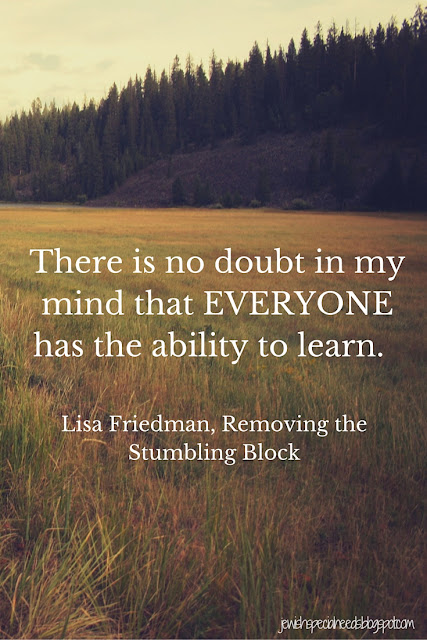There is no doubt in my mind that EVERYONE has the ability to learn.
We just
each go about it differently. From Proverbs, “Teach a child according to
his/her own way,” but how do you discover a learner’s “way”? One thought is that a child’s “way” is
his/her learning style.
Learning
style is defined as an individual’s preferred mode of gaining knowledge. There
are three basic learning styles that are most widely utilized; visual, auditory
and kinesthetic. However, four additional categories are also generally
accepted; social, logical, verbal and solitary.
I know that I am primarily a visual learner. How do I know this? When one of my children yells out to me, “Hey mom, what does I-N-S-U-R-M-O-U-N-T-A-B-L-E mean?” I will usually reply, “Come here…I need to see it.” Similarly, when attending a lecture or a workshop, I take notes or tweet about what the presenter is saying. For me, the writing (kinesthetic) and then being able to see the information helps me to retain what I have learned.
I know that I am primarily a visual learner. How do I know this? When one of my children yells out to me, “Hey mom, what does I-N-S-U-R-M-O-U-N-T-A-B-L-E mean?” I will usually reply, “Come here…I need to see it.” Similarly, when attending a lecture or a workshop, I take notes or tweet about what the presenter is saying. For me, the writing (kinesthetic) and then being able to see the information helps me to retain what I have learned.
We all use
every learning style, but have dominance in certain areas. I demonstrated a
blend of two learning styles above, despite first asserting my dominance as a
visual learner. Further, our dominance is not fixed and can shift given the
experience, and it is possible to learn or improve dominance in any given
area. Using a student’s preferred
learning style is a logical and effective way to differentiate instruction and
improve student motivation and achievement.
However, not
everyone embraces the practice of teaching to preferred learning styles. In an interesting article by Reed Gillespie
called “The
Pitfalls of Learning Styles and How We Got Duped Into Believing in Them” he
states, “Today I cringe when my well-meaning peers talk about using – sometimes
even paying for – learning style inventories…”
He goes on to assert that not only is there no proof that understanding
learning styles improves learning, but that using them could actually be
dangerous. He says, “Labels shape expectations, lead to exaggerations and
perpetuate the notion that a student is not capable – or not as capable – of
success.” Rings true for those of us involved in special education...
My daughter
handed me her most recent spelling test where she missed five words out of
twenty. When I asked what happened she replied, “I’m not good at spelling”. Compare
this to Reed’s story of John who struggles with reading and writing. Throughout
middle school John is given opportunities to express his learning through art
and drawing, as this preferred modality is where he excels. Yet, when he
arrives in high school, John is ill-equipped to handle high school writing
assignments and suffers poor grades. Reed argues that we have set John up for
failure. And as I tell my daughter, being “bad at spelling” isn’t an excuse, but
rather a wake up call, to improve her skills.
What do you think? When we strive to teach children “according to their own way” are we missing the mark? Do we deprive our children of the opportunity to strengthen areas of weakness when we seek to cater to their strengths?
Be sure you never miss a post from Removing the Stumbling Block:


When you get into business world I would argue you want to play to someone's strengths because at that point time and money are important factors. But to apply same principles to o education system is off the mark. This is place to experiment, erase these perceptions, raise level of expectations and provide critical thinking skills for our children to succeed in our global world.
ReplyDeleteThanks Shel, and I agree...we need to give our children every opportunity to succeed in the world!
DeleteI don't think it is an "either-or". I think understanding the child's strengths/weaknesses helps us to help him/her more effectively. For example, when pushing in an area of weakness, I would say "This is really hard, isn't it? Here, let's do it together a few times until it gets easier." Pushing in an area of strength would look more like a high-level direction, expecting the child to fill in more of the blanks independently. Sometimes I overestimate the strength, so I can follow up with "Start on your own, and ask for help if you get stuck." In an area of weakness, it would be more like "Let's start together, and you'll let me know when you can be more independent".
ReplyDeleteAs far as different modalities go, it is good to present material in multiple modalities, and let the learner decide what works best in each situation.
Terrific insight. I especially love the way you illustrate your commitment to finding the right balance. Thank you.
Delete